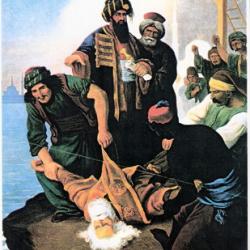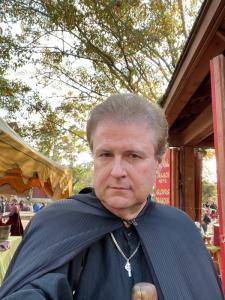 C.S. Lewis was certainly a Christian, but an uncertain Platonist. A comparison to his contemporary A.E. Taylor, author of a magisterial commentary on Timaeus, is helpful in showing the debt Lewis owed the Platonic dialogue. Taylor was a Christian, an apologist, and was (somewhat unreasonably) proud of his prosody. Lewis was the better writer, though no poet, the greater apologist (though Taylor’s Does God Exist? is underrated), but sometimes lacks Taylor’s rigor and consistency.
C.S. Lewis was certainly a Christian, but an uncertain Platonist. A comparison to his contemporary A.E. Taylor, author of a magisterial commentary on Timaeus, is helpful in showing the debt Lewis owed the Platonic dialogue. Taylor was a Christian, an apologist, and was (somewhat unreasonably) proud of his prosody. Lewis was the better writer, though no poet, the greater apologist (though Taylor’s Does God Exist? is underrated), but sometimes lacks Taylor’s rigor and consistency.
C.S. Lewis baptized my imagination, Taylor my Platonism, but oddly it is C.S. Lewis who captured the essential Timaeus.
Few outside of professional philosophy read Taylor today, but even a quick read of his Commentary reminds anyone who grew up on Lewis how many ideas C.S. Lewis borrowed from Timaeus. If Lewis was never a thorough or consistent Platonist, especially in later life, Plato’s greatest psychological work, Timaeus, informs much of Lewis’ writing.
This debt makes sense, because for most of Western history the Timaeus was Plato. A Latin translation of the dialogue made Plato the consummate cosmology to scholars of the Middle Ages. Exposure to Aristotle and further evidence modified this Platonic imagery, but never fully supplanted it until modern times. As author of Discarded Image, Lewis deftly handled this period and his scholarly book on sixteenth century literature acknowledges the debt this period still owed to Plato’s Timaeus. Any reading of Milton, given an excellent treatment by Lewis in his Preface, also shows the abiding influence of Timaeus.
Despite the use made of it in the Middle Ages, and by Lewis in his fiction, the Timaeus is not primarily cosmological, but psychological. Taylor follows the mistakes of the Medieval and describes in loving detail a Timaeus that is primarily a Platonic experiment in telling anachronistic scientific stories. On Taylor’s view, Timaeus does not contain Plato’s opinions, but Socrates. Timaeus is the sort of science Socrates would have done if Socrates had done science or so says A.E. Taylor. Despite spending hundreds of pages on the argument, few are persuaded.
C.S. Lewis never wrote a commentary on Timaeus, or so far as I can tell anything dealing with the dialogue directly, but the use he makes of the text in his writing is superficially cosmological, but deeply psychological. In doing this Lewis grasps what Taylor, the true expert, missed. The first line of the Platonic dialogue has Socrates counting the guests at an intellectual feast, “One, two, three . . . where is the fourth?” Socrates will then recapitulate a conversation held the day before that is suspiciously like that held in the first five books of Republic.
When the great lion Aslan counts the children at the Stone Table he asks the same question: “Where is the fourth?” The missing fourth is Edmund, who has become a traitor. At the end of The Lion, the Witch, and the Wardrobe Edmund is redeemed and becomes a king in Narnia . . . remembered as “King Edmund the Just.” It is surely no accident that the Republic has the search for justice in the soul as its theme and that the main interlocutor for Socrates, Glaucon, is missing from the Timaeus. If his little Platonic joke is intentional Lewis has grasped a point about Timaeus Taylor misses: the cosmology of the dialogue is an attempt to find justice.
Republic uses the image of a city, but it has proven too small to find justice and so now Plato will use the largest image of all, the cosmos, to look for justice so he can recognize it in when he turns to look into the soul of a human being.
Understanding Plato’s object makes sense of the part of the dialogue that is often skipped by modern philosophers for the more analytic sections that follow: the myth of Atlantis. Later at 28b, Socrates will solve the problem of posed by Parmenides: how can change occur when that which is not cannot be. He will do so by a biological analogy: becoming exists as a state “between” is and is not.
The myth of Atlantis is a “becoming”
Plato creates a new world with a fantastic history that contains truth, at least as much truth as most of the images we receive from the “becoming” state in which we live at present. Plato grasps that all of science is story telling, some more “likely” based on experience that other tales told.
Against what “the becoming,” however, stands “what should have become” and since this is a better reflection of the eternal existence Good (the only being that “is”) what should have become has a reality that what became cannot have. There are for Plato three histories: bad fiction, mere lies, myth, and what became. What we call history if it lacks justice also to that existence falls short of being and so the more likely story, the myth: what should have been, has a truth that mere history lacks.
Many children and C.S. Lewis grasped this: Narnia is not historical, but it is mythic. To the extent that Narnia, like Atlantis, tells a story of what should have been in justice as opposed to what “happened” in the perverse world it is more “real” that history. Where Lewis and Plato differ is where Christianity and Plato part ways: Plato believes that cosmos contains irrational laws that prevent perfect justice while Christian knows the cosmos is fallen from perfection because of separation from God.
——————————————
Modified from a lecture at The College at Saint Constantine and an earlier draft at HBU.













